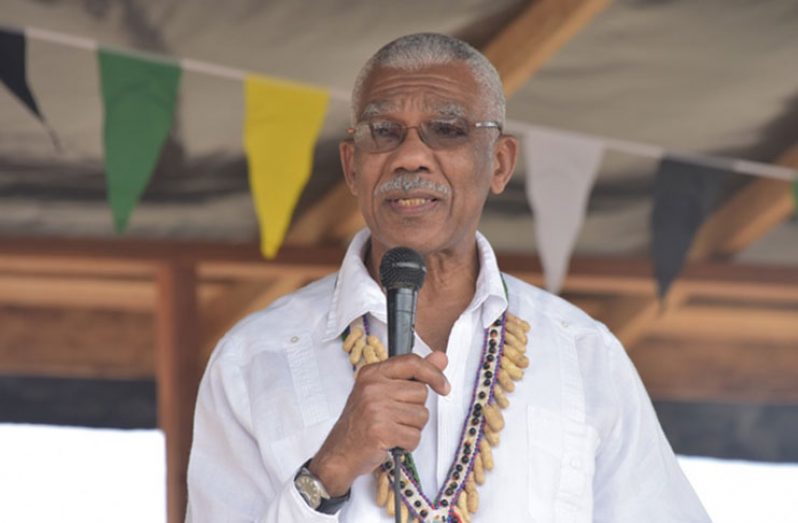President David Granger has called on the Indigenous leaders of the Potaro/Siparuni region to work along with regional administration to improve economic development through agro-processing.

The Head of State made the call during a visit to the village of Tuseneng where he addressed the fifth North Pakaraima Exposition on Monday. According to the Department of Public Information (DPI), the President during his address to the residents underscored that the region has a fertile valley and is capable of producing some of the finest agriculture products in the country.
The Head of State said, “this is one of the potentially richest regions in Guyana…people cannot eat gold, they cannot eat diamonds, they have to eat food and the people who produce the food are the ones who will make the profit. And so, I am asking the Toshaos to work with the regional administration to see how we can get more food to the miners, more food to the market and this can be done through agro-processing; meaning, that everything you grow can be processed and taken to the market.”
Region Eight spans 20,000 square kilometres and it is five times the size of Trinidad and Tobago and according to President Granger, “this region, is the roof of Guyana, it is the highest part of the entire country. This should be a powerful region in terms of its prosperity and its economy.”
As regards the development of the Tuseneng Village, the Head-of-State said that he was honoured to be the first president to visit this small developing village with a population of just about 100 people. “I have come here to examine the potential of the community and to see in what ways we can increase the profit, and ensure there is greater participation and provide that opportunity for you to do better. There is hope that this community could be resurrected economically and spiritually.”
The President also spoke of the importance of the exposition, which forms part of the Regional Agriculture Commercial Exhibition (RACE), an initiative which the government has been promoting throughout the country.
Such events, he said, are aimed at creating platforms to encourage entrepreneurs to invest in the regions, particularly the hinterland.
“… But we know the big problem is one of infrastructure, getting the products to the markets… It hurts me to know that the only way I [can travel] to the east…of the Potaro-Siparuni [and]… to the west is by something called a ‘Safari’. I don’t want a `Safari’, I want the people to be able to drive from east to west and north to south, just like any other region. However, we cannot do it this week or next month, but we are working to develop the infrastructure in this region,” President Granger said.
Minister of Indigenous Peoples’ Affairs,Sydney Allicock, who accompanied the President, told the residents that the government is aware of the many issues affecting the citizens. He, however, pointed out that hinterland development is a process and that process has already begun.

“We are a government that is providing a service to all our people in Guyana and not a section, but each and every one. And, in order to achieve this, we need communication because through communication we can get information, and the information is knowledge and knowledge is power. This is not a government thing, it’s not a village thing or a regional thing, it is an approach by the government for all to be included in the process of development,” he said.
Minister Allicock also spoke of the need for Tuseneng to develop its Village Improvement Plan (VIP), which will allow the people to manage their territory. Minister within the Ministry of Indigenous Peoples’ Affairs, Valerie Garrido-Lowe spoke of the efforts by the government to bridge the gap between the hinterland and the coastland. She also took the opportunity to highlight some of the developments taking shape in the region such as the ‘Pakaraima Flavour’ tomato project in Paramakatoi and the Lapidary Workshop being implemented at Monkey Mountain.
The annual expo provides a platform for local producers to showcase their products, and brings together the residents of the North Pakaraima, tourists, investors, and businesses. It also provides the rest of Guyana an opportunity to experience the rich indigenous traditions through cultural presentations, art, craft, foods, beverages, and games.
Among the villages that participated are Kanapang, Penak, Itabac, Kurukubaru, Kato, and Chuing Mouth.



.jpg)










